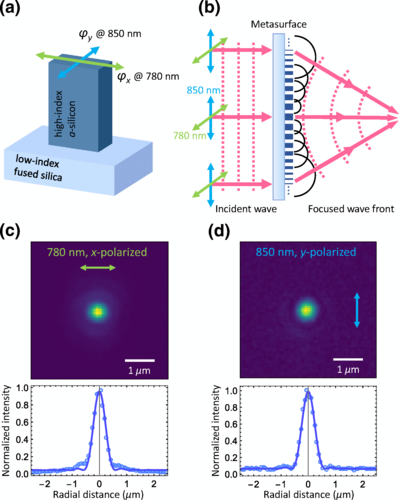Physicists from the National Institute of Standards and Technology and the University of Colorado have created a metasurface
Traditional optical tweezers, for creatingwhich were awarded the Nobel Prize in 2018, are bulky centimeter-sized lenses and complex optical systems. In their work, published in the journal PRX Quantum, the researchers used a square glass plate about 4 mm long. Scientists have applied millions of tiny columns several hundred nanometers high to its surface.
 Scheme of the device. Image: Sean Kelley/NIST
Scheme of the device. Image: Sean Kelley/NIST
Such an optical metasurface focuseslaser light to trap, manipulate and display individual atoms. Unlike conventional optical tweezers, the device can operate in a vacuum containing a cloud of trapped atoms.
Incident light, having a particularly simple shape,known as a plane wave strikes groups of tiny nanopillars, the scientists explain. Groups of nanopillars turn plane waves into a series of small waves - wavelets, each of which is slightly out of sync with the next. As a result, neighboring wavelets reach their peak at slightly different times. These wavelets combine or "interfere" with each other and focus all their energy on a specific location - the location of the atom to be captured.
 Nanopillar device. Image: T.-W. Hsu et al., PRX Quantum
Nanopillar device. Image: T.-W. Hsu et al., PRX Quantum
Depending on the angle at which the incomingplane light waves are incident on nanopillars, wavelets are focused in different places, which allows the optical system to capture a number of individual atoms located in slightly different places from each other. In their work, the scientists used a metasurface to capture nine individual atoms of rubidium. The authors note that a scaled-up system will be able to hold hundreds of individual atoms.
The developed lens during the experimentheld the atoms in place for about 10 seconds. This is enough to study the quantum mechanical properties of particles and use them to store quantum information.
Read more:
Scientists filmed a strange creature with tentacles, which they mistook for a flower
On the moon, they found a place where the temperature is always comfortable for humans
AI has appeared that monitors processes and proposes new laws of physics